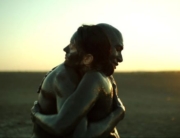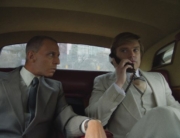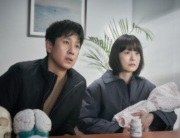
Tom Amandes as Abraham Lincoln in SAVING LINCOLN (Pictures from the Fringe)
The 150th anniversary of the Civil War, combined with the Hollywood and Oscar drumbeat for Steven Spielberg’s Lincoln, rolls on with more cinematic celebrations that take two extreme directions—a dazzling looking docudrama and the satirical documentary The Battle of Pussy Willow Creek.
Saving Lincoln takes two striking steps away from Spielberg’s focus on the president’s last months. Flashing back from Lincoln’s assassination in 1865, this story stretches through his whole political career, starting with the close camaraderie of his lawyer pals on the court circuit in Illinois. The perspective and narration is provided by the banjo-playing, displaced Virginian Ward Hill Lamon (Lea Coco), which emphasizes the bonhomie and male bonding loyalty Lincoln (a warmly personable Tom Amandes) generates.
Lamon’s longtime friendship turned to concern for Lincoln’s safety when death threats emerged even before the inauguration in March 1861. Reluctantly, Lincoln appoints Lamon a U.S. Marshall to serve as his personal bodyguard at a time when police forces and Pinkerton detectives were just beginning. Lamon was close to the family as well, and the film clearly shows how the instability of Mary Todd Lincoln (Penelope Ann Miller), was aggravated by the tragic 1862 death of her son Willie in the White House. She turned, like many in the grief-consumed nation, to a medium.
From this historical accurate standpoint, director Salvador Litvak takes a further step in visual authenticity by thrusting the actors directly into archival photographs from the Library of Congress, made by the likes of Matthew Brady and Alexander Gardner. Using a technique Litvak calls “CineCollage,” the 19th century black-and-white photographs—including a capital landscape where the Washington Monument is still under construction—are green-screened behind the actors, who seamlessly move through the effects and sets that extend the images into 3-D. This not only enlivens the photographs as more than just backgrounds, but also simulates popular period stereoscopy, panoramas, and tableaux vivants. This innovative look, the primary reason to see the film, is particularly striking in the lively outdoor scenes, such as Lincoln’s inaugural train trip East and his visits to battlefields (a famous shot of Lincoln with General McClellan is meticulously recreated), as well as the unimpressed crowds for the Gettysburg Address. The feeling of realism is aided by effective sound design.
The effect is something like a “living history” stage set, and that’s how the best of the ensemble—including Bruce Davison as Secretary of State William H. Seward, Josh Stamberg as Secretary of the Treasury Salmon P. Chase, and Creed Bratton as Senator Charles Sumner—treat it as they move through the space, some of whom put life into the otherwise stiff and stolid script. The film inevitably heads to the post-war assassination, with Lincoln’s shaking Lamon off to enjoy plays at Ford’s Theater. (John Wilkes Booth glaring up at the presidential box from the stage looks simplistically exaggerated, and makes the fatal shot anti-climactic.)






Leave A Comment